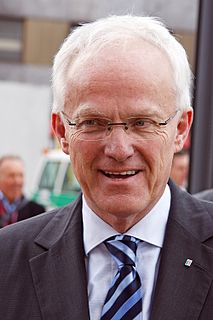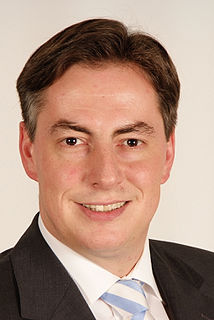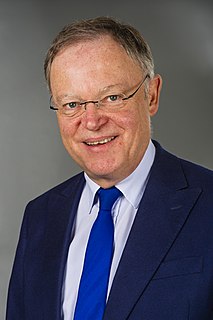
The Free Democratic Party is a liberal and classical liberal political party in Germany. The FDP is led by Christian Lindner.
The Saxony state election of 2004, was conducted on 19 September 2004, to elect members to the Landtag of Saxony.
The state election to elect members of the Landtag of Hesse was held in the German state of Hesse on 27 January 2008.
The Politics of Hesse takes place within a framework of a federal parliamentary representative democratic republic, where the Federal Government of Germany exercises sovereign rights with certain powers reserved to the states of Germany including Hesse. The state has a multi-party system where, as in most other states of former Western Germany and the federal level, the two main parties are the centre-right Christian Democratic Union (CDU) and the centre-left Social Democratic Party of Germany (SPD).

The Politics of Lower Saxony takes place within a framework of a federal parliamentary representative democratic republic, where the Federal Government of Germany exercises sovereign rights with certain powers reserved to the states of Germany including Lower Saxony. Since 1948 politics in the state has been dominated by the rightist Christian Democratic Union (CDU) and the leftist Social Democratic Party. Lower Saxony was one of the origins of the German environmentalist movement in reaction to the state government's support for underground nuclear waste disposal. This led to the formation of the German Green Party in 1980.

The Landtag of Hesse is the Parliament of the State of Hesse in the Federal Republic of Germany. It convenes in the Stadtschloss, Wiesbaden. As a Legislature it is responsible for passing laws at the state level and enacting the budget. Its most important function is to elect and control the state government. The constitution of the State of Hesse describes the role of the Landtag in §§ 75 to 99.
Early state elections for the Landtag of Hesse were held in Hesse on 18 January 2009. The reason for the early elections was the inability of the parties to form a government after the inconclusive 2008 Hessian election.
In modern Germany with its parliamentary system of government on federal and on state level, grand coalition describes a governing coalition of the two biggest parties in one parliament. In most cases this means a coalition of the Union and the Social Democrats (SPD).

The North Rhine-Westphalia state election, 2010, was an election held on 9 May 2010, to elect members to the Landtag of the German state of North Rhine-Westphalia. The incumbent government at the election was the Christian Democrat (CDU)–FDP administration of Minister-President Jürgen Rüttgers. The biggest opposition party was the Social Democratic Party, led by Hannelore Kraft since 2005.
The German Party was a national-conservative political party in West Germany during the post-war years.

A state election was held in Lower Saxony on 20 January 2013 to elect the 137 members of the Landtag.

A state election was held on 31 August 2014 in the state of Saxony in Germany, as required by the state constitution. Minister-President Stanislaw Tillich sought to retain power.

The Baden-Württemberg state election 2016 was held on 13 March 2016 to elect members to Baden-Württemberg's State diet, the Landtag of Baden-Württemberg in Stuttgart. It was the 15th state election since the foundation of Baden-Württemberg in 1952. Going into the election, Winfried Kretschmann of Alliance '90/The Greens led a coalition government of his party with the Social Democrats. After the election, Kretschman was confirmed in May 2016 leading a coalition with the CDU, the first time the Greens have led such a coalition in Germany.

The 2016 Rhineland-Palatinate state election was held on 13 March 2016 to elect all 101 members to the Landtag of Rhineland-Palatinate. Seats are allotted by proportional representation with a 5% threshold. State elections were held on the same day in Baden-Württemberg and Saxony-Anhalt.

State elections were held in Saarland on 26 March 2017. All 51 seats in the Landtag of Saarland were up for election. The incumbent Minister-President Annegret Kramp-Karrenbauer went into the election leading a grand coalition of her Christian Democratic Union (CDU) and the Social Democratic Party (SPD), seeking re-election after serving two terms as Minister-President.
The next German federal election for the 20th Bundestag will regularly be held between August and October 2021.

The SPD party member vote on the 2018 coalition agreement of Germany took place from 20 February to 2 March 2018. The members of the SPD party decided per postal vote whether the coalition treaty with CDU and CSU parties will be accepted or not. The result, 66.02% in favor of the Yes campaign, was published on 4 March 2018. It was decisive for Angela Merkel's plan to get re-elected as chancellor of Germany on 14 March in the German Bundestag.





















